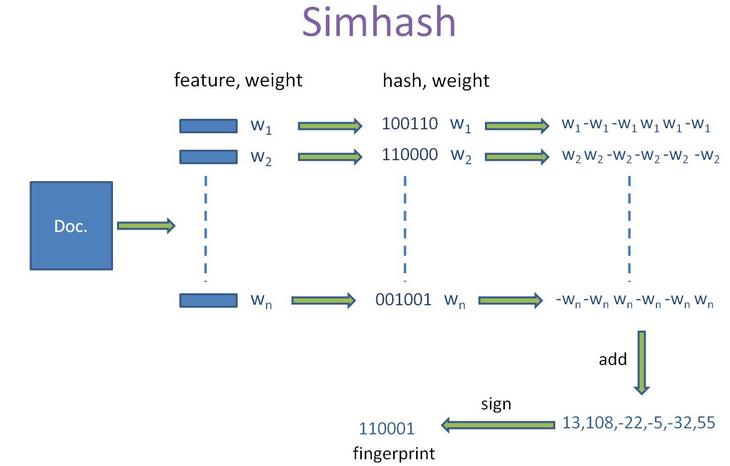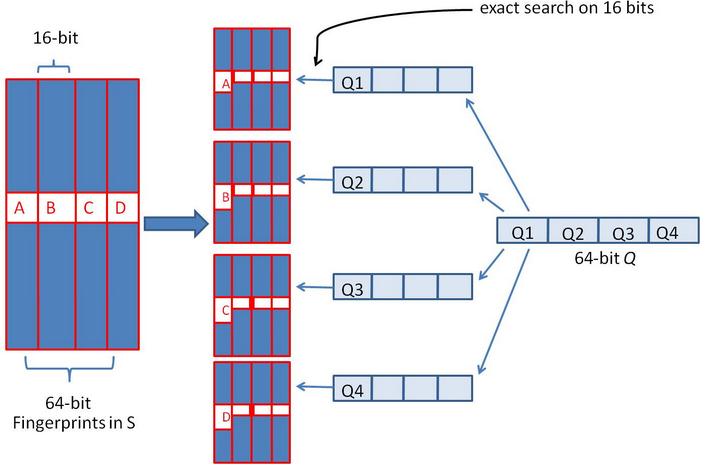http://gemantic.iteye.com/blog/1701101
simHash 简介以及java实现
传统的hash 算法只负责将原始内容尽量均匀随机地映射为一个签名值,原理上相当于伪随机数产生算法。产生的两个签名,如果相等,说明原始内容在一定概率 下是相等的;如果不相等,除了说明原始内容不相等外,不再提供任何信息,因为即使原始内容只相差一个字节,所产生的签名也很可能差别极大。从这个意义上来 说,要设计一个 hash 算法,对相似的内容产生的签名也相近,是更为艰难的任务,因为它的签名值除了提供原始内容是否相等的信息外,还能额外提供不相等的 原始内容的差异程度的信息。
而Google 的 simhash 算法产生的签名,可以用来比较原始内容的相似度时,便很想了解这种神奇的算法的原理。出人意料,这个算法并不深奥,其思想是非常清澈美妙的。
Simhash算法
simhash算法的输入是一个向量,输出是一个 f 位的签名值。为了陈述方便,假设输入的是一个文档的特征集合,每个特征有一定的权重。比如特征可以是文档中的词,其权重可以是这个词出现的次数。 simhash 算法如下:
1,将一个 f 维的向量 V 初始化为 0 ; f 位的二进制数 S 初始化为 0 ;
2,对每一个特征:用传统的 hash 算法对该特征产生一个 f 位的签名 b 。对 i=1 到 f :
如果b 的第 i 位为 1 ,则 V 的第 i 个元素加上该特征的权重;
否则,V 的第 i 个元素减去该特征的权重。
3,如果 V 的第 i 个元素大于 0 ,则 S 的第 i 位为 1 ,否则为 0 ;
4,输出 S 作为签名。


算法几何意义和原理
这个算法的几何意义非常明了。它首先将每一个特征映射为f 维空间的一个向量,这个映射规则具体是怎样并不重要,只要对很多不同的特征来说,它们对所对应的 向量是均匀随机分布的,并且对相同的特征来说对应的向量是唯一的就行。比如一个特征的 4 位 hash 签名的二进制表示为 1010 ,那么这个特征对应的 4 维向量就是(1, -1, 1, -1) T ,即hash 签名的某一位为 1 ,映射到的向量的对应位就为 1 ,否则为 -1 。然后,将一个文档中所包含的各个特征对应的向量加权求和, 加权的系数等于该特征的权重。
得到的和向量即表征了这个文档,我们可以用向量之间的夹角来衡量对应文档之间的相似度。最后,为了得到一个f 位的签名,需要 进一步将其压缩,如果和向量的某一维大于 0 ,则最终签名的对应位为 1 ,否则为 0 。这样的压缩相当于只留下了和向量所在的象限这个信息,而 64 位的签名可以 表示多达 2 64 个象限,因此只保存所在象限的信息也足够表征一个文档了。
比较相似度
海明距离: 两个码字的对应比特取值不同的比特数称为这两个码字的海明距离。一个有效编码集中, 任意两个码字的海明距离的最小值称为该编码集的海明距离。举例如下: 10101 和 00110 从第一位开始依次有第一位、第四、第五位不同,则海明距离为 3.
异或: 只有在两个比较的位不同时其结果是1 ,否则结果为 0
对每篇文档根据SimHash 算出签名后,再计算两个签名的海明距离(两个二进制异或后 1 的个数)即可。根据经验值,对 64 位的 SimHash ,海明距离在 3 以内的可以认为相似度比较高。
假设对64 位的 SimHash ,我们要找海明距离在 3 以内的所有签名。我们可以把 64 位的二进制签名均分成 4块,每块 16 位。根据鸽巢原理(也成抽屉原理,见组合数学),如果两个签名的海明距离在 3 以内,它们必有一块完全相同。
我们把上面分成的4 块中的每一个块分别作为前 16 位来进行查找。 建立倒排索引。

如果库中有2^34 个(大概 10 亿)签名,那么匹配上每个块的结果最多有 2^(34-16)=262144 个候选结果 (假设数据是均匀分布, 16 位的数据,产生的像限为 2^16 个,则平均每个像限分布的文档数则 2^34/2^16 = 2^(34-16)) ,四个块返回的总结果数为 4* 262144 (大概 100 万)。原本需要比较 10 亿次,经过索引,大概就只需要处理 100 万次了。由此可见,确实大大减少了计算量。
Java 代码实现:
- package com.gemantic.nlp.commons.simhash;
- import java.math.BigInteger;
- import java.util.ArrayList;
- import java.util.List;
- import java.util.StringTokenizer;
- public class SimHash {
- private String tokens;
- private BigInteger intSimHash;
- private String strSimHash;
- private int hashbits = 64;
- public SimHash(String tokens) {
- this.tokens = tokens;
- this.intSimHash = this.simHash();
- }
- public SimHash(String tokens, int hashbits) {
- this.tokens = tokens;
- this.hashbits = hashbits;
- this.intSimHash = this.simHash();
- }
- public BigInteger simHash() {
- int[] v = new int[this.hashbits];
- StringTokenizer stringTokens = new StringTokenizer(this.tokens);
- while (stringTokens.hasMoreTokens()) {
- String temp = stringTokens.nextToken();
- BigInteger t = this.hash(temp);
- for (int i = 0; i < this.hashbits; i++) {
- BigInteger bitmask = new BigInteger("1").shiftLeft(i);
- if (t.and(bitmask).signum() != 0) {
- v[i] += 1;
- } else {
- v[i] -= 1;
- }
- }
- }
- BigInteger fingerprint = new BigInteger("0");
- StringBuffer simHashBuffer = new StringBuffer();
- for (int i = 0; i < this.hashbits; i++) {
- if (v[i] >= 0) {
- fingerprint = fingerprint.add(new BigInteger("1").shiftLeft(i));
- simHashBuffer.append("1");
- }else{
- simHashBuffer.append("0");
- }
- }
- this.strSimHash = simHashBuffer.toString();
- System.out.println(this.strSimHash + " length " + this.strSimHash.length());
- return fingerprint;
- }
- private BigInteger hash(String source) {
- if (source == null || source.length() == 0) {
- return new BigInteger("0");
- } else {
- char[] sourceArray = source.toCharArray();
- BigInteger x = BigInteger.valueOf(((long) sourceArray[0]) << 7);
- BigInteger m = new BigInteger("1000003");
- BigInteger mask = new BigInteger("2").pow(this.hashbits).subtract(
- new BigInteger("1"));
- for (char item : sourceArray) {
- BigInteger temp = BigInteger.valueOf((long) item);
- x = x.multiply(m).xor(temp).and(mask);
- }
- x = x.xor(new BigInteger(String.valueOf(source.length())));
- if (x.equals(new BigInteger("-1"))) {
- x = new BigInteger("-2");
- }
- return x;
- }
- }
- /**
- * 取两个二进制的异或,统计为1的个数,就是海明距离
- * @param other
- * @return
- */
- public int hammingDistance(SimHash other) {
- BigInteger x = this.intSimHash.xor(other.intSimHash);
- int tot = 0;
- //统计x中二进制位数为1的个数
- //我们想想,一个二进制数减去1,那么,从最后那个1(包括那个1)后面的数字全都反了,对吧,然后,n&(n-1)就相当于把后面的数字清0,
- //我们看n能做多少次这样的操作就OK了。
- while (x.signum() != 0) {
- tot += 1;
- x = x.and(x.subtract(new BigInteger("1")));
- }
- return tot;
- }
- /**
- * calculate Hamming Distance between two strings
- * 二进制怕有错,当成字符串,作一个,比较下结果
- * @author
- * @param str1 the 1st string
- * @param str2 the 2nd string
- * @return Hamming Distance between str1 and str2
- */
- public int getDistance(String str1, String str2) {
- int distance;
- if (str1.length() != str2.length()) {
- distance = -1;
- } else {
- distance = 0;
- for (int i = 0; i < str1.length(); i++) {
- if (str1.charAt(i) != str2.charAt(i)) {
- distance++;
- }
- }
- }
- return distance;
- }
- /**
- * 如果海明距离取3,则分成四块,并得到每一块的bigInteger值 ,作为索引值使用
- * @param simHash
- * @param distance
- * @return
- */
- public List<BigInteger> subByDistance(SimHash simHash, int distance){
- int numEach = this.hashbits/(distance+1);
- List<BigInteger> characters = new ArrayList();
- StringBuffer buffer = new StringBuffer();
- int k = 0;
- for( int i = 0; i < this.intSimHash.bitLength(); i++){
- boolean sr = simHash.intSimHash.testBit(i);
- if(sr){
- buffer.append("1");
- }
- else{
- buffer.append("0");
- }
- if( (i+1)%numEach == 0 ){
- BigInteger eachValue = new BigInteger(buffer.toString(),2);
- System.out.println("----" +eachValue );
- buffer.delete(0, buffer.length());
- characters.add(eachValue);
- }
- }
- return characters;
- }
- public static void main(String[] args) {
- String s = "This is a test string for testing";
- SimHash hash1 = new SimHash(s, 64);
- System.out.println(hash1.intSimHash + " " + hash1.intSimHash.bitLength());
- hash1.subByDistance(hash1, 3);
- System.out.println(" ");
- s = "This is a test string for testing, This is a test string for testing abcdef";
- SimHash hash2 = new SimHash(s, 64);
- System.out.println(hash2.intSimHash+ " " + hash2.intSimHash.bitCount());
- hash1.subByDistance(hash2, 3);
- s = "This is a test string for testing als";
- SimHash hash3 = new SimHash(s, 64);
- System.out.println(hash3.intSimHash+ " " + hash3.intSimHash.bitCount());
- hash1.subByDistance(hash3, 3);
- System.out.println("============================");
- int dis = hash1.getDistance(hash1.strSimHash,hash2.strSimHash);
- System.out.println(hash1.hammingDistance(hash2) + " "+ dis);
- int dis2 = hash1.getDistance(hash1.strSimHash,hash3.strSimHash);
- System.out.println(hash1.hammingDistance(hash3) + " " + dis2);
- }
- }
参考: http://blog.sina.com.cn/s/blog_72995dcc010145ti.html
http://blog.sina.com.cn/s/blog_56d8ea900100y41b.html
http://blog.csdn.net/meijia_tts/article/details/7928579